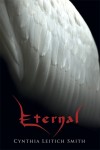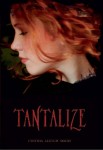
Cynthia Leitich Smith on Living in a Multicultural World

Author Cynthia Leitich Smith is well known in the children's literature world as much for her Cynsations ![]() interviews of other authors as for her own books.
interviews of other authors as for her own books. ![]() She is an enthusiastic supporter of her fellow authors, rooting them on whenever there's good news to share. She also has a rich resource for multicultural literature on her website, and her books have multicultural characters and themes. Her first books were acclaimed realistic novel Rain is Not My Indian Name and picture book Jingle Dancer, as well as the holiday picture book Santa Knows. More recently, she's been writing YA fantasy set in the multicultural world of Austin, Texas, in Tantalize, Eternal, and upcoming sequels. (Check out her book trailers.
She is an enthusiastic supporter of her fellow authors, rooting them on whenever there's good news to share. She also has a rich resource for multicultural literature on her website, and her books have multicultural characters and themes. Her first books were acclaimed realistic novel Rain is Not My Indian Name and picture book Jingle Dancer, as well as the holiday picture book Santa Knows. More recently, she's been writing YA fantasy set in the multicultural world of Austin, Texas, in Tantalize, Eternal, and upcoming sequels. (Check out her book trailers. ![]() )
)
Today, we talk to her about living in a multicultural world. I especially love her answers (and everyone's answers so far) about her reading preferences as a teen, because we're all so different, and we each have different needs and interests as readers. This is something that we especially want to keep in mind at Tu Books. Note also her answers for writers interested in writing in multicultural worlds—wise words to remember.
Stacy Whitman: You've been writing for years, but your first YA fantasy novel came out just a few years ago. In Tantalize and its sequels, a lot of multicultural influences come together. Can you tell us a little about your background and where you live, and the influences on your books?
Cynthia Leitich Smith: Yes, Tantalize ![]() was published by Candlewick in 2007, and its companions (to date) are Eternal
was published by Candlewick in 2007, and its companions (to date) are Eternal ![]() (2009) and Blessed (2011). There's also a graphic novel adaptation of Tantalize in the works. The books are set in contemporary Austin, but also a universe with angels, shapeshifters, vampires, and ghosts. The casts are diverse—including protagonists like Kieren Morales, who's Irish-Mexican American, and Miranda, who's Chinese-Scottish American, and angels who're described as looking black or Latino or otherwise mixed race (among others).
(2009) and Blessed (2011). There's also a graphic novel adaptation of Tantalize in the works. The books are set in contemporary Austin, but also a universe with angels, shapeshifters, vampires, and ghosts. The casts are diverse—including protagonists like Kieren Morales, who's Irish-Mexican American, and Miranda, who's Chinese-Scottish American, and angels who're described as looking black or Latino or otherwise mixed race (among others).
 I'm a mixed blood-tribal member of Muscogee Nation, which is based in Oklahoma, where my mother and her family hail from. My husband
I'm a mixed blood-tribal member of Muscogee Nation, which is based in Oklahoma, where my mother and her family hail from. My husband ![]() is Japanese-German American. We make our home in Austin, Texas, which is a university town with students, faculty, and visitors from around the world as well as a diverse residential population. The Mexican American community and culture heavily influences the city.
is Japanese-German American. We make our home in Austin, Texas, which is a university town with students, faculty, and visitors from around the world as well as a diverse residential population. The Mexican American community and culture heavily influences the city.
It seems completely natural for me to offer novels with diverse casts—it would be impossible to depict, say, south Austin without including, say, Latinos, foreign students, and for that matter 'kickers and hippies.
You interview so many people for your blog ![]() (mirrors on Livejournal
(mirrors on Livejournal ![]() and MySpace
and MySpace ![]() )—you seem to be at the crossroads, telling people about everyone else's news. You also have some really great resources on your site for readers and writers alike, including book lists of multicultural books broken down by culture and a database of freelance editors. What got you started doing this? Particularly on the book lists, news & notes, and interviews, why do you feel it's important to share this information with readers?
)—you seem to be at the crossroads, telling people about everyone else's news. You also have some really great resources on your site for readers and writers alike, including book lists of multicultural books broken down by culture and a database of freelance editors. What got you started doing this? Particularly on the book lists, news & notes, and interviews, why do you feel it's important to share this information with readers?
After an early childhood flirtation with poetry, my earliest writing years were spent as a journalist. I was editor of my junior high and high school newspapers and majored in news/editorial at college. When my law school classmates were working as clerks at law firms, I was writing feature stories about high-profile people for The Dallas Morning News. The only thing I didn't like about it was the emphasis on bad news, which has become ever greater in the years since. My blog, Cynsations, allows me an opportunity to share good news of children's-YA literature, its creators, and the people who connect books to young readers. So I suppose I'm fulfilling my inner journalist.
Beyond that, when I quit my day job to write full time, it wasn't just about my own writing. Don't get me wrong, I'm passionate about my creative work. But I'm also a terrific fan of the conversation of books and a big believer in community.
 Since Tantalize is all about the food, what are your top five favorite foods from around the world?
Since Tantalize is all about the food, what are your top five favorite foods from around the world?
Hamachi sashimi, shrimp migas, Kansas City-style barbecue (sorry, Texas), and macaroni and cheese.
What are the top five things you'd recommend writers remember when working on characterization or worldbuilding in fantasy?
- To the extent possible, step into your fictional world. Walk the streets (or their models) that your characters walk, find wardrobes for them, sketch or identify a physical model for each.
- Keep a bible of the world, so you have it for easy reference.
- Earn your fantasy element—it must be internally consistent, necessary, and relate to some aspect of the real world.
- Remember your fantasy beings are going to have to be more human than humans.
- Use sensory and other details to act as a springboard for suspension of disbelief.
Not necessarily a "top" five list, because we all have so many favorites, but can you recommend five new authors of multicultural literature for children or young adults—preferably fantasy/science fiction/mystery—for readers to keep a look out for?
- Cindy Pon,
 author of Silver Phoenix: Beyond the Kingdom of Xia
author of Silver Phoenix: Beyond the Kingdom of Xia - David Macinnis Gill,
 author of Soul Enchilada
author of Soul Enchilada - Grace Lin,
 author of Where the Mountain Meets the Moon (Grace isn't a new
voice but she's new to fantasy novel writing)
author of Where the Mountain Meets the Moon (Grace isn't a new
voice but she's new to fantasy novel writing) - Ellen Jensen Abbott,
 author of Watersmeet (a high fantasy which offers a look into
prejudice/discrimination)
author of Watersmeet (a high fantasy which offers a look into
prejudice/discrimination) - Kekla Magoon,
 author of The Rock and the River (realistic fiction, but still a
terrific author)
author of The Rock and the River (realistic fiction, but still a
terrific author)
Five fascinating cultures that are underrepresented in fantasy/science fiction for young readers?
So many . . . in the U.S., I'd like to see more depictions of those of Arab, Native, Polish (especially new immigrant), Appalachian, and African American heritage (among others). That said, I'd caution those writing cross-culturally against defaulting to "mystical" or "exotic" stereotypes—do your homework. And on the Native American front, remember that a lot of what the mainstream categorizes as "myth" is part of traditional belief systems and should be afforded the same respect as other faiths.
**And some questions that I'll ask everyone, because I love the answers we get:
When you were a teen, did you read much fantasy? Why or why not?**
Yes, especially Stephen King's novels and pretty much anything I could find at the library. The only bookstore was a small one, based at the local mall, and I bought a lot of Star Wars and Star Trek tie-in novels there.
Was it important for you as a teen reader to read books in which there were people like you, to find a personal connection to the story? Was there a time when you first felt that sense of connection to a book, a sense that you identified with the character or felt more comfortable with the setting, that you could tell us about?
Honestly, I tended to avoid books with Native characters. They didn't ring true to me, and often made me feel embarrassed. Avoidance is my defense strategy. I'm a huge "Buffy" fan, for example, but didn't watch "Pangs," which I've been told by Native friends was probably a good thing for maintaining my enthusiasm.
The theme of Teen Read Week was "Read Beyond Reality." Teen Read Week is over, but we think it's still a great motto for readers year-round. How does reading take you beyond your own reality? What do you look for in a good book?
I'm looking for a fantasy that helps me make sense of my reality, even if I don't realize it at the time, even if I've told myself it's pure escapism.
How would you encourage teen readers to read beyond reality?
I tend to highlight conversations with authors. For Teen Read Week, I pointed my readers to books that had a complimentary fantasy element—vampires or angels—to my latest release, Eternal.
Why is multicultural literature important to you? Why do you think it's important for the teens who read your books?
My world is multicolorful—diverse in terms of ethnicity, race, orientation, faith. My books should be too. Teens like to see vibrant, fascinating characters of varying backgrounds and hues. Of late, a teen wrote me:
"Nice to see an Asian girl pick up a battle-axe!"
We couldn't have said it better.
Contact Us
Telephone: (212) 779-4400 x 28
Email: quotes[at]leeandlow[dot]com
Educator's Newsletter: Subscribe
FREE Teacher's Guides
Helpful educator resources can be found at our Educators






